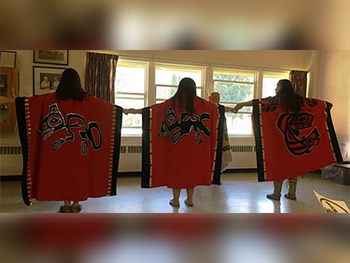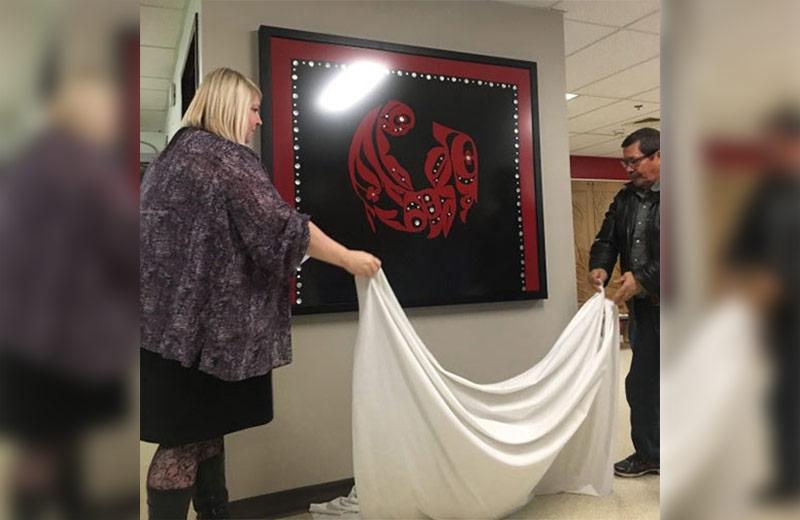This past fall, Mary Vanstone, local administrator for Wrinch Memorial Hospital in Hazelton, hosted an event celebrating the unveiling of Gitxsan art. Local Indigenous artwork in health care settings helps to create a more welcoming and culturally safe space. For many people at the event, the commissioning and unveiling of this artwork was more impactful than expected.
Artwork unveiling was impactful
The artwork symbolizes robes of authority with a crest that depicts the Indian Residential School experience from the Gitxsan perspective. The Northwest East Aboriginal Health Improvement Committee commissioned the art for the hospital entrance as part of an initiative funded by Aboriginal Health to develop local cultural resources.
The art was made by residential school survivors participating in the Gitxsan Health Society Indian Residential School Resolution Health Support Program. At the unveiling event, several people who participated in its creation spoke about its meaning and their experiences working on it. Indian Residential School Resolution Health Support Worker Pamela Torres described the sessions where Indian Residential School survivors and family members from Kispiox, Sikedakh, and Gitanmaax came together, shared their stories, experiences, tears, and laughter as they worked to complete the beautiful artwork.
Also at the event, fellow support worker Gary Patsey described his experiences as an Indian Residential School survivor. He spoke about specific statistics of residential school impacts on the Gitxsan Huwilp and shared sensitive insights into his journey of healing. He challenged service providers to educate themselves on the 94 Calls to Action flowing from the final report of the Truth and Reconciliation Commission of Canada.
Ardythe Wilson, manager of the support program, concluded the event with a reminder that all health care workers and service providers in the area are in positions where they can become partners of true reconciliation by working with, and supporting, the Gitxsan in developing a reconciliation model. The unveiling was a significant event and those in attendance were visibly moved.
Artwork recognizes those who suffered
The art was designed by Michelle Stoney, whose grandparents survived residential school and now actively promote Gitxsan history and culture. The crest represents the four clans of the Gitxsan Huwilp inside a mother and child, portraying the matrilineal foundation of the Gitxsan Nation. It recognizes those who suffered the abduction of their children and the intergenerational healing that continues to take place as a result of the long-reaching impacts of residential schools.
Vanstone shared:
It was an honour to help organize and be part of this event. The unveiling event provided an open forum for discussion and a step toward healing from the atrocities of the residential school system and the trauma sustained by First Nations in this community. As a health facility supporting the people of this community, we acknowledge that we have a lot of work left to do, however, we are confident in the collaborative relationships we are building with our community partners. The artwork hangs in our foyer as a symbolic reminder of the unbreakable bond between mother and child and the strength provided by the Wolf, Fireweed, Frog and Eagle clans of the Gitxsan people.
Verna Howard, Community Engagement Coordinator with the First Nations Health Authority, helped organize this event and said:
This event has made a big difference. It’s the first time we have seen our First Nations people and dancers involved in the hospital system. I could see on the elders’ faces the impact the cultural dance group and cultural recognition had, especially for those who reside there. The community members and residential school survivors, who have heard talk about reconciliation but have seen little action, saw this as a great step forward.
The event followed local Gitxsan protocols with Chief George Gray providing a formal welcome to the traditional Gitxsan territory and Elder Frances Sampson, opening the event with a prayer. Following the unveiling, there was a reception in the cafeteria where the Gitxsan Cultural dancers performed. Verna Howard and I spoke about the role of Aboriginal Health Improvement Committees and how Northern Health, First Nations Health Authority, and Indigenous communities and organizations are partnering to improve the health of Indigenous peoples in the North. Hereditary Chief Ray Jones, a residential school survivor, shared about the three constant companions in residential school: hunger, loneliness, and fear.
Cormac Hikisch, Health Services Administrator for the Northwest area said,
I was grateful to be a part of this event – witnessing local residential school survivors share their stories and express appreciation for the button blanket as recognition of their suffering. It helped provide me with a better understanding of the real impacts to this tragic part of Canadian history, and more deeply realize the still current trauma that First Nations are working to move forward from.
A step towards making health care environments more culturally safe

This event was one step in Northern Health’s journey to honour and acknowledge local First Nations and making health care environments more culturally safe.
The women who created this blanket are Amanda Wesley, Theresa Stevens, Virginia Fowler, Rebecca Jagoda, Cindy Martin and Mae Martin with guidance from Marjorie Mowatt and Sadie Mowatt. Final touch-ups were provided by Lavender Macdonald.














Comments